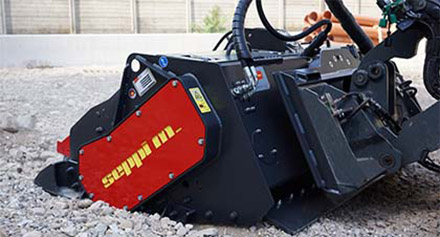Seppi’s new MINISOIL cl has been built for all skid steer type tractors (SAE Standard) and meets the compact loader category with reduced dimensions and weights. Source: Timberbiz
The weight of the MINISOIL cl is 1160 kg for a working width of 150cm. Ther equired oil flow rate can vary between 105 to 250 l/min and the pressure can vary between 150 – 380bar. This is thanks to the dual drive with two M-BOOST type axial piston hydraulic engines with automatically variable displacement. These engines are used on most SEPPI hydraulic mulchers with many advantages:
- the torque varies automatically according to the load
- up to 40% more torque
- automatic displacement change
- the mulcher rotor gains speed much faster
- reduced work times.
The dual drives ensure high torque. The carbon chain toothed belts are strong and easy to replace. The automatic adaptability of the engines is important for work in different conditions.
The high pressure and low rotor speed allow for work at a depth of about 10cm and allow for stones with a diameter of up to 15cm to be crushed. Lighter material, such as wood, can be chopped up quickly, cutting logs and bushes with a diameter of up to 20cm.
All of this is possible thanks to the patented rotor with fixed tools protected by tungsten carbide reinforcements on the parts most exposed to wear.
The machine is made using high-strength materials with interchangeable wear-resistant steel plates. Moreover, the mulching quality increases thanks to three rows of very strong crushing bars and one adjustable anvil bar. Therefore, stones or wood are chopped three times inside the frame before leaving the machine.
Another important advantage of MINISOIL cl is its low profile, which optimises the operator’s field of vision. The front, with a fixed hood, protects the rotor from the stones coming out and is clearly visible from the operator’s position. The ground to be mulched can therefore be observed safely, working at the maximum speed and efficiency.






